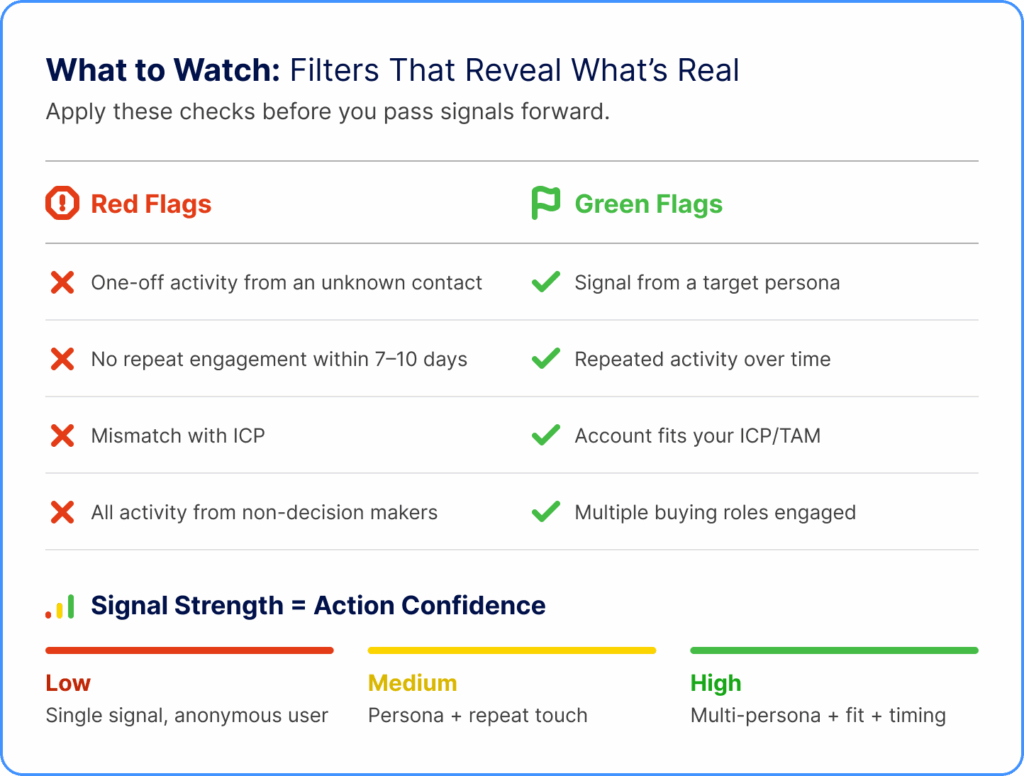
It starts with a spike. It always does.
Your dashboard lights up with a surge in “intent.” Engagement spikes, the team celebrates. Feels like momentum, until it isn’t. No return calls from the customer. Follow-ups go unanswered. What looked like progress turns out to be noise.
It’s a familiar scene for marketers chasing intent data. But what is “intent data” in actuality – and why does so much of it create activity that never converts?
We call it the Marketing Data Mirage, the illusion of buying interest created by shallow signals and overinterpreted behaviors. It looks like growth, but it’s not.
Taylor Young, Director of Solutions & Advisory Services at DemandScience, described it best in the Turning Signals Into Sales webinar: “Marketing is over here celebrating that we’ve got the most website visitors we’ve ever had in history and we’re throwing a party, while Sales is saying, ‘We missed pipeline this month’.”
It’s not a follow-up problem; it’s a signal-trust problem. And it’s costing marketers more than budget; it’s costing confidence.
The good news? Once you know how to see through the Data Mirage, you can stop chasing activity and start acting on what’s real.
When Signals Create False Confidence
The Data Mirage doesn’t just distort dashboards; it seeps into strategy.
Unqualified signals look like engagement, but they rarely mean readiness. A single asset view, a weak keyword spike, or a burst of anonymous web traffic can trick teams into moving too fast. Without context—who engaged, how often, and whether they fit your ICP—signals are just noise dressed up as insight.
“Marketers feel like they’re checking all the boxes,” Young explained. “They’ve bought all the tools, they’ve got all the data, but more data doesn’t mean better strategy.”
The danger of the Data Mirage is that it feels like progress. It convinces marketing that pipeline is growing while sales is left holding leads that were never ready. And when expectations built on false confidence collapse, so does trust between teams, metrics, and the process itself.

Turning Signals Into Sales
Signal ≠ Intent ≠ Trigger: The Hidden Confusion
Here’s where it all starts to unravel.
Marketers often use signal, intent, and trigger interchangeably, but each means something different. Understanding what buyer intent data is versus simple engagement metrics is critical.
In the world of B2B intent data, that confusion is amplified because more signals don’t always mean more readiness. That lack of shared definition between teams leads to early activation, wasted spend, and misalignment.
| Term | What It Looks Like | What It Really Means |
| Signal | Any observable behavior — click, view, download. | A raw data point, unverified and often misleading without context or validation. |
| Intent | Behavioral evidence of interest or readiness. | A pattern of signals that shows consistent topical interest over time. |
| Buying Signal | “The account is ready to buy.” | Intent + fit + behavioral context that suggest purchase consideration — the difference between research and readiness. |
| Trigger | “Any intent means activate.” | The moment when verified buying signals justify activation by both marketing and sales. |
Many teams treat intent signals as proof of readiness, when in reality they’re often just digital noise. For example, multiple employees from the same company consuming data integration content shows intent, but until a verified buyer downloads a pricing guide, it’s not a buying signal. (Using Intent Data: How to Spot Buying Signals Like a Pro)
As Evan Ortiz, Sr. Global Growth Marketing Manager at Google, noted:
“At first, everything can look like a signal or a trigger. The key is understanding what leads to what — that’s what clarifies the data and connects the dots.”
Without that shared clarity, teams act too early, too often, on signals that never convert. The result? A mirage of motion, and a pipeline built on sand.
Signal Readiness: From Reaction to Alignment
Intent data only works when both marketing and sales trust what it’s saying. For teams using B2B buyer intent data, success depends on cross-team confidence and clear activation criteria. That doesn’t happen by buying another tool. It happens by building shared understanding around what real B2B intent data means and when to act on it.
Think of signal readiness as a maturity mindset. Every organization sits somewhere along this journey:
| Stage | What It Feels Like | What’s Missing | What To Do |
| 1. Every Click Feels Urgent | Teams chase one-off downloads and keyword spikes. Sales ignores most “leads.” | Qualification and timing | Pause before you pass. Validate who’s engaging and why. |
| 2. Patterns, but Not Proof | You start to see clusters of engagement, but sales still questions timing and relevance. | Context and ICP alignment | Collaborate with sales to define activation thresholds and strengthen shared confidence. |
| 3. Shared Triggers, Shared Trust | Multi-persona engagement and agreed-upon timing drive coordinated outreach. | Continuous optimization and feedback loops | Maintain alignment. Keep refining data, timing, and readiness together to move from reactive to predictable. |
As Dominic Milan, Lead Connections Media Strategist at Dentsu B2B, said:
“At the briefing stage, bring sales in from the start. Know who matters, who’s ready, and make sure everyone’s moving in the same direction.”
Signal readiness isn’t a process; it’s a mindset. The more aligned your teams are on what “real intent” means, the fewer false starts they’ll chase.
Real Filters, Not Fantasy Scores
For many teams, an “87” intent score gets christened as a hot lead. But when sales pushes back, “We’ve never heard of this account,” the gap becomes painfully clear.
Intent scores are the Data Mirage’s favorite disguise: certainty without substance.
Without context—account fit, buyer journey stage, and validated behavioral patterns—a score is just math. And math can’t replace expertise.
Only 18% of B2B organizations have a measurable intent strategy. Scores alone can’t explain why a lead matters or when it’s ready. When intent scores fall short, apply these filters before passing signals forward:

It’s Never Been a Volume Game. It’s Always Been a Confidence Game.
The best marketers aren’t chasing more B2B intent data; they’re learning to see what’s real. Verified signals reveal who’s ready to engage. Everything else is just noise. A mirage.
Once you stop mistaking activity for intent and start qualifying what’s real, alignment follows. Sales trusts the data. Marketing trusts the process. And pipeline becomes predictable again.
At DemandScience, we believe intent isn’t about more data. It’s about clarity — the ability to see what’s real, connect what matters, and act with confidence. Ready to see intent for what it truly is, and what it can actually deliver?










